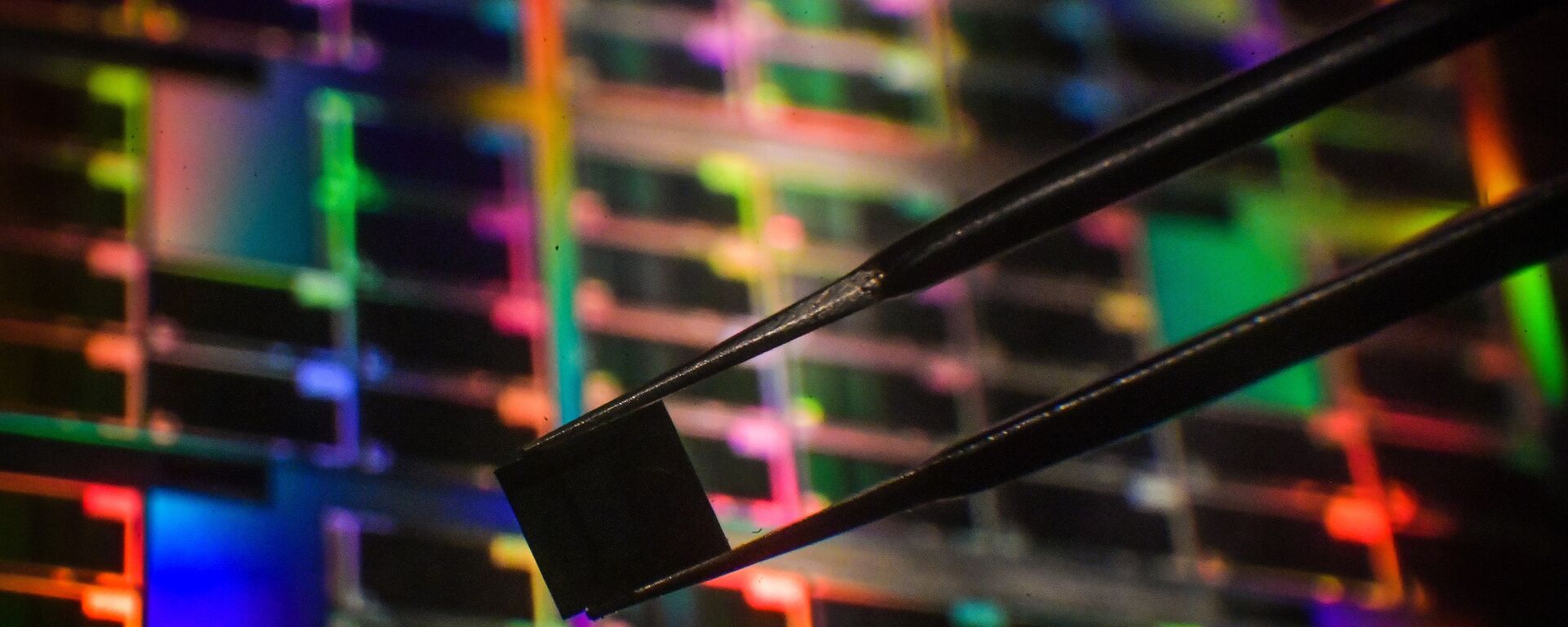https://sputniknews.in/20230622/india-set-to-chip-away-at-growing-semi-conductor-nationalism-of-us--2607676.html
India Set to Chip Away at Growing Semi-Conductor Nationalism of US
India Set to Chip Away at Growing Semi-Conductor Nationalism of US
Sputnik India
Indian Prime Minister Narendra Modi has urged American companies to boost the semiconductor manufacturing ecosystem in India under the ‘Make in India’ policy.
2023-06-22T14:40+0530
2023-06-22T14:40+0530
2023-06-22T14:40+0530
business & economy
narendra modi
us
joe biden
gautam adani
china
semi-conductor chips
global supply chains
western sanctions
science & tech
https://cdn1.img.sputniknews.in/img/07e7/06/16/2612627_0:160:3072:1888_1920x0_80_0_0_9d8bd0b9d64662ab4f553a3ee3832b87.jpg
Indian Prime Minister Narendra Modi has urged American companies to boost the semiconductor manufacturing ecosystem in India under the ‘Make in India’ policy, which essentially involves transferring the crucial technology to the South Asian nation.Statements from the Prime Minister’s Office revealed that Modi had met Gary E. Dickerson and Sanjay Mehrotra, the respective CEOs of Applied Materials and Micron, in Washington, DC on Wednesday.According to a report by Reuters on Tuesday, the Indian cabinet has approved a plan by Micron Technology to pour $2.7 billion into establishing a semiconductor testing and packaging plant in Gujarat.The Indian leader invited Applied Materials to set up a plant for the development of process technology and advanced packaging capabilities in the country, according to the statement.Modi’s meetings with the American CEOs come against the backdrop of New Delhi’s efforts to position India as a global hub for semiconductor manufacturing.India and the US have also launched an initiative on Critical and Emerging Technology (iCET) in order to cooperate further in the realm of semiconductors.At present, New Delhi largely relies on foreign imports to meet its semiconductor requirements. PM Modi has said that the domestic consumption of semiconductors would hit $110 billion by 2030.Modi has announced $10 billion in Production Linked Incentives (PLI) for semiconductor companies wanting to set up factories in the country.India’s Minister of State (MoS) for Electronics and Information Technology Rajeev Chandrasekhar said last month that around 27 semiconductor start-ups have sprung up in the South Asian country, with their number expected to rise to 100 in the coming months.Semiconductors are used in the automobile, defence, electronics and IT industries, and are therefore crucial to various sectors of the economy.India’s Concerns With Growing ‘Semi-Conductor Nationalism’As one of the fastest-growing economies, India has raised alarm bells about growing protectionism in the semiconductor industry and the implications of such policies on global supply chains.Last year, Indian business magnate Gautam Adani decried what he called “semi-conductor nationalism” following the Biden administration’s decision to slap restrictions on the sale of high-end chips to China and Russia.The Biden administration has also introduced the CHIPS and Science Act of 2022, geared towards boosting manufacturing in the United States.Like several other countries, India was impacted by the disruptions in the semiconductor supply chains during the Covid pandemic, with several automobile companies reporting a decline in sales due to a shortage of electric components produced with the help of semiconductors.
https://sputniknews.in/20230311/india-us-ink-memorandum-on-semiconductor-supply-chain-1132172.html
https://sputniknews.in/20230616/global-south-hardest-hit-by-supply-chain-disruptions-in-agriculture---pm-modi--2514288.html
us
china
Sputnik India
feedback.hindi@sputniknews.com
+74956456601
MIA „Rossiya Segodnya“
2023
Dhairya Maheshwari
https://cdn1.img.sputniknews.in/img/07e6/0c/13/138962_0:0:641:640_100x100_80_0_0_2cb44360dbcdf6d84bf4b299cd045917.jpg
Dhairya Maheshwari
https://cdn1.img.sputniknews.in/img/07e6/0c/13/138962_0:0:641:640_100x100_80_0_0_2cb44360dbcdf6d84bf4b299cd045917.jpg
News
en_IN
Sputnik India
feedback.hindi@sputniknews.com
+74956456601
MIA „Rossiya Segodnya“
Sputnik India
feedback.hindi@sputniknews.com
+74956456601
MIA „Rossiya Segodnya“
Dhairya Maheshwari
https://cdn1.img.sputniknews.in/img/07e6/0c/13/138962_0:0:641:640_100x100_80_0_0_2cb44360dbcdf6d84bf4b299cd045917.jpg
semiconductor companies in india, semiconductor fab, chips act, modi us visit, modi in us, india us relations, india us news, india us icet
semiconductor companies in india, semiconductor fab, chips act, modi us visit, modi in us, india us relations, india us news, india us icet
India Set to Chip Away at Growing Semi-Conductor Nationalism of US
PM Modi arrived in Washington, DC on Wednesday on an official visit, where he was hosted by US First Lady Jill Biden at the White House, and held informal talks with President Joe Biden. The Indian premier's formal engagements will kick off on Thursday.
Indian Prime Minister Narendra Modi has urged American companies to boost the semiconductor manufacturing ecosystem in India under the ‘Make in India’ policy, which essentially involves transferring the crucial technology to the South Asian nation.
Statements from the Prime Minister’s Office revealed that Modi had met Gary E. Dickerson and Sanjay Mehrotra, the respective CEOs of Applied Materials and Micron, in Washington, DC on Wednesday.
“He (Modi) noted that India can provide competitive advantages in various parts of the semiconductor supply chain,” the Indian statement underlined after the meeting between Modi and Mehrotra.
According to a report by Reuters on Tuesday, the Indian cabinet has approved a plan by Micron Technology to pour $2.7 billion into establishing a semiconductor testing and packaging plant in Gujarat.
The Indian leader invited Applied Materials to set up a plant for the development of process technology and advanced packaging capabilities in the country, according to the statement.
Modi’s meetings with the American CEOs come against the backdrop of New Delhi’s efforts to position India as a global hub for semiconductor manufacturing.
India and the US have also launched an initiative on
Critical and Emerging Technology (iCET) in order to cooperate further in the realm of semiconductors.
At present, New Delhi largely relies on foreign imports to meet its semiconductor requirements. PM Modi has said that the domestic consumption of semiconductors would hit $110 billion by 2030.
Modi has announced $10 billion in Production Linked Incentives (PLI) for semiconductor companies wanting to set up factories in the country.
India’s Minister of State (MoS) for Electronics and Information Technology Rajeev Chandrasekhar said last month that around 27 semiconductor start-ups have sprung up in the South Asian country, with their number expected to rise to 100 in the coming months.
Semiconductors are used in the automobile, defence, electronics and IT industries, and are therefore crucial to various sectors of the economy.
India’s Concerns With Growing ‘Semi-Conductor Nationalism’
As one of the fastest-growing economies, India has raised alarm bells about growing protectionism in the semiconductor industry and the implications of such policies on global supply chains.
Last year, Indian business magnate Gautam Adani decried what he called “semi-conductor nationalism” following the Biden administration’s decision to slap restrictions on the sale of high-end chips to China and Russia.
The Biden administration has also introduced the CHIPS and Science Act of 2022, geared towards boosting manufacturing in the United States.
Like several other countries, India was impacted by the disruptions in the semiconductor supply chains during the Covid pandemic, with several automobile companies reporting a decline in sales due to a shortage of electric components produced with the help of semiconductors.




